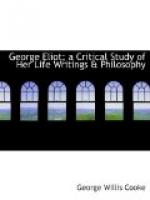For the next ten years Sir Christopher was occupied with the architectural metamorphosis of his old family mansion, thus anticipating through the prompting of his individual taste that general re-action from the insipid imitation of the Palladian style towards a restoration of the Gothic, which marked the close of the eighteenth century. This was the object he had set his heart on, with a singleness of determination which was regarded with not a little contempt by his fox-hunting neighbors.... “An obstinate, crotchety man,” said his neighbors. But I, who have seen Cheverel Manor as he bequeathed it to his heirs, rather attribute that unswerving architectural purpose of his, conceived and carried out through long years of systematic personal exertion, to something of the fervor of genius.
In this story an incident in the life of Sir Roger Newdigate may have been made use of by George Eliot. He was childless, and adopted a cottager’s child he and his wife heard singing at its father’s door one day. They educated the child, who proved to have a fine voice and a passionate love of music.
Janet’s Repentance also has its scenes from actual life. Dr. Dempster was thought to be recognized by his neighbors as a well-known person in Nuneaton. Milby and its High street are no other than Nuneaton and its market-place. The character of the town and the manner of life there are all sketched from the Nuneaton of George Eliot’s childhood. The school she attended was very near the vicarage. While she was attending this school, when about nine years old, a young curate from a neighboring hamlet was permitted by the Bishop to give Sunday-evening lectures in the Nuneaton church, with the results described in Janet’s Repentance.
In Adam Bede there is also a considerable element of actual history. The heroine, Dinah Morris, is, in some slight particulars at least, sketched from Elizabeth Evans, an aunt of George Eliot’s. Elizabeth Evans was born at Newbold, Lincolnshire, in 1776. [Footnote: This subject has been fully worked out in a book published by Blackwood, “George Eliot in Derbyshire: a volume of gossip about passages in the novels of George Eliot,” by Guy Roslyn. Reprinted from London Society, with alterations and additions, and an introduction by George Barnett Smith. Its statements are mainly based on a small book published in London in 1859, by Talbot & Co., entitled “Seth Bede, the Methody: his Life and Labors.” Guy Roslyn is a pseudonym for Joshua Hatton.] She was a beautiful woman when young, with soft gray eyes and a fine face, and had a very simple and gentle manner. She was a Methodist preacher, lived at Wirksworth, Derbyshire, and preached wherever an opportunity occurred. When it was forbidden that women should preach, she continued to exhort in the cottages, and to visit the poor and the sick in their homes. She married Samuel Evans, who was born in Boston, and was a carpenter.




